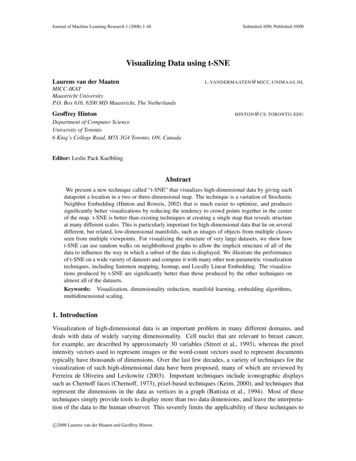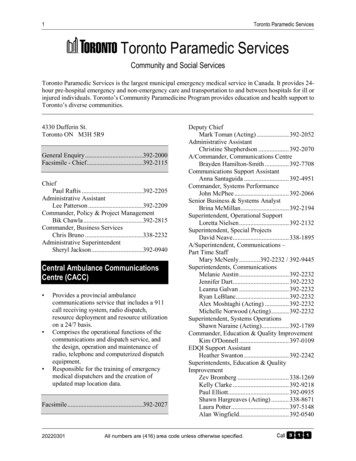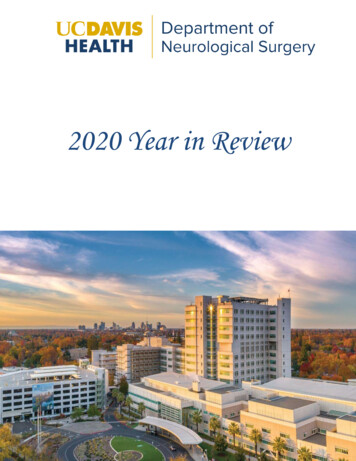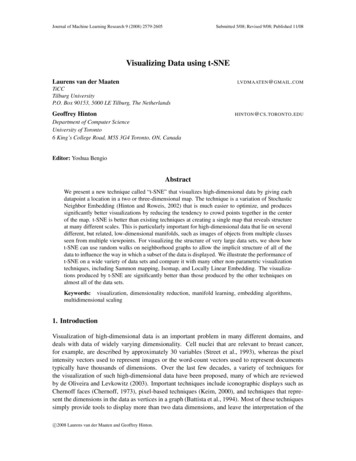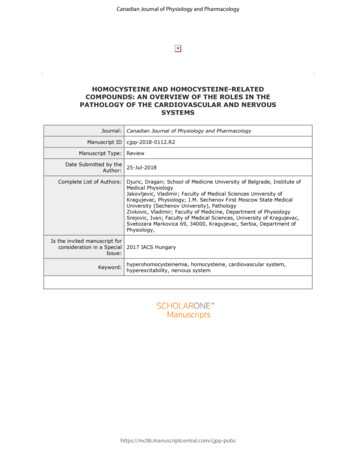
Transcription
Canadian Journal of Physiology and PharmacologyHOMOCYSTEINE AND HOMOCYSTEINE-RELATEDCOMPOUNDS: AN OVERVIEW OF THE ROLES IN THEPATHOLOGY OF THE CARDIOVASCULAR AND NERVOUSSYSTEMSJournal: Canadian Journal of Physiology and PharmacologyManuscript ID cjpp-2018-0112.R2Manuscript Type: ReviewDate Submitted by the25-Jul-2018Author:aftDrComplete List of Authors: Djuric, Dragan; School of Medicine University of Belgrade, Institute ofMedical PhysiologyJakovljevic, Vladimir; Faculty of Medical Sciences University ofKragujevac, Physiology; I.M. Sechenov First Moscow State MedicalUniversity (Sechenov University), PathologyZivkovic, Vladimir; Faculty of Medicine, Department of PhysiologySrejovic, Ivan; Faculty of Medical Sciences, University of Kragujevac,Svetozara Markovica 69, 34000, Kragujevac, Serbia, Department ofPhysiology,Is the invited manuscript forconsideration in a Special 2017 IACS HungaryIssue:Keyword:hyperohomocysteinemia, homocysteine, cardiovascular system,hyperexcitability, nervous systemhttps://mc06.manuscriptcentral.com/cjpp-pubs
Page 1 of 62Canadian Journal of Physiology and PharmacologyHOMOCYSTEINE AND HOMOCYSTEINE-RELATED COMPOUNDS: ANOVERVIEW OF THE ROLES IN THE PATHOLOGY OF THE CARDIOVASCULARAND NERVOUS SYSTEMSDragan Djuric1, Vladimir Jakovljevic2,3, Vladimir Zivkovic2, Ivan Srejovic21Instituteof Medical Physiology "Richard Burian" Faculty of Medicine, University of Belgrade,Visegradska 26, 11000 Belgrade, Serbia2Universityof Kragujevac, Faculty of Medical Sciences, Department of Physiology, SvetozaraMarkovica 69, 34000 Kragujevac, SerbiaSechenov First Moscow State Medical University (Sechenov University), Department ofDr3I.M.Human Pathology, Trubetskaya st. 8, Moscow 119991, RussiaaftCorrespondence should be addressed to:Prof. Dragan Djuric, MD, PhDInstitute of Medical Physiology "Richard Burian" Faculty of Medicine, University of BelgradeVisegradska 26, 11000 Belgrade, SerbiaPhone number: 381 11 360 71 12Fax: 381 11 361 12 61e-mail address: dr m/cjpp-pubs
Canadian Journal of Physiology and PharmacologyList of Abbreviations:5-MTHF - 5-methyltetrahydrofolateACE - angiotensin-converting enzymeANGII - angiotensin IIBH4 - tetrahydrobiopterinCBS - cystathionine β-synthasecGMP - cyclic guanosine 3’,5’-monophosphateCVD - cardiovascular diseaseCys - L-cysteineeNOS - endothelial nitric oxide synthaseET-1 - endothelin-1FAD - flavin adenine dinucleotideFMN - flavin mononucleotideaftDrERK - extracellular-signal-regulated protein kinaseGPx - glutathione peroxidaseGSH - reduced glutathioneH2O2 - hydrogen peroxideHO-1 - heme oxygenase 1iNOS - inducible nitric oxide synthaseIRAK - IL-1R-associated kinaseJNK - Jun kinases/SAPKMAPK - mitogen-activated protein kinaseMMP - matrix com/cjpp-pubsPage 2 of 62
Page 3 of 62Canadian Journal of Physiology and PharmacologyMAT - methionine adenosyltransferaseMetRS - methionyl-tRNA synthetaseMS - methionine synthaseMyD88 - myeloid differentiation primary response gene 88NAC - N-acetyl-L-cysteineNADPH oxidase - nicotinamide adenine dinucleotide phosphate-oxidaseNF-κB - nuclear factor kappa BNMDA – N-methyl-D-aspartateNOS - nitric oxide sinthaseNOS - nitric oxide OHDrO2- - superoxide anion- hydroxyl radicalaftONOO- - peroxynitriteRBC - red blood cellsSAH - S-adenosylhomocysteineSOD - superoxide dismutaseTIR - toll/interleukin-1 receptorTIRAP - toll-Interleukin I receptor domain-containing adaptor proteinTLR4 - toll-like receptor 4TRAM - TRIF-related adaptor moleculeTRIF - TIR domain-containing adaptor protein inducing interferon-bTNF-α - tumor necrosis factor alpha3https://mc06.manuscriptcentral.com/cjpp-pubs
Canadian Journal of Physiology and PharmacologyPage 4 of 62ABSTRACTHomocysteine, sulfhydryl group containing amino acid, is intermediate product duringmetabolism of the amino acids methionine and cysteine. Hyperhomocysteinema (HHcy) is usedas a predictive risk factor for cardiovascular disorders, the stroke progression, screening forinborn errors of Met metabolism, and as a supplementary test for vitamin B12 deficiency. Twoorganic systems in which homocysteine (Hcy) has the most harmful effects are thecardiovascular and nervous system. The adverse effects of Hcy are achieved by the action ofseveral different mechanisms, such as overactivation of NMDA receptors, activation of TLR-4,disturbance in Ca2 handling, increased activity of NADPH oxidase and subsequent increase ofproduction of reactive oxygen species, increased activity of NOS and NOS uncoupling andDrconsequent impairment in NO and ROS synthesis. Increased production of reactive speciesduring HHcy are related with increased expression of several proinflammatory cytokines,aftincluding IL-1β, IL-6, TNF-α, MCP-1, and intracellular adhesion molecule-1. All thesemechanisms contribute to the emergence of diseases like atherosclerosis and relatedcomplications such as myocardial infarction, stroke, aortic aneurysm, as well as Alzheimerdisease and epilepsy. This review provides evidence that supports the causal role for HHcy in thedevelopment of CVD and nervous system ine,hyperexcitability, nervous scardiovascularsystem,
Page 5 of 62Canadian Journal of Physiology and PharmacologyINTRODUCTIONHomocysteine, sulfhydryl group containing amino acid, is intermediate product duringmetabolism of the amino acids methionine and cysteine (McBreairty 2016; Selhub and Troen2016). Homocysteine is nonprotein amino acid which behaves as both a substrate and product ofmethionine. Homocysteine has key role in methylation cycle, within which a methyl group istransferred to a different substrate (Fernández-Arroyo et al. 2016). Formed homocysteine can beutilized in two ways: 1) homocysteine can be remethylated to methionine by catalytic activity ofthe enzyme N5, N10-methylenetetrahydrofolate reductase; 2) homocysteine can be converted tocysteine in a reaction that is catalyzed by cystathionine β-synthase (CBS) (Faeh et al. 2006;Ganguly and Alam 2015).DrMETABOLIC FATE OF HOMOCYSTEINE AND REALTED COMPOUNDSaftMethionine is an essential amino acid, whose quantity in the body depends exclusively on thediet. Metabolic importance of methionine is reflected in the large number of transmethylationreactions, which result in transfer of one carbon methyl group to various substrates (DNA, RNA,proteins, phospholipids, polysaccharides, catecholamine, choline) during the methionine cycle.Methionine is also source in synthesis of other sulfur-containing compounds (cysteine andtaurine). Taking into account the limitation of dietary supply of methionine, it should be paidattention on importance of methionine synthesis by remethylation of homocysteine (Figure 1).During the methionine cycle, the first step is conversion of methionine to Sadenosylmethionine (SAM), in reaction regulated by ATP and enzyme methionineadenosyltransferase (MAT). Methyl groups can be transferred from SAM to various substratemolecules in reaction catalyzed by various methyltransferases. During these reactions SAM is5https://mc06.manuscriptcentral.com/cjpp-pubs
Canadian Journal of Physiology and Pharmacologytransformed into S-adenosylhomocysteine (SAH). SAH is then hydrolyzed to adenosine andhomocysteine in reversible reaction regulated enzyme SAH hydrolase. This point has a key rolein the further direction of homocysteine metabolism - remethylation or transsulfuration (Ables etal. 2016; Steed and Tyagi 2011).Homocysteine undergo the remethylation process in case of methionine deficiency. Thismetabolic pathway requires folic acid as donor of methyl groups for methionine restoration(Pizzolo et al. 2011). Remethylation is catalyzed by methionine synthase (MS), enzyme that usesvitamin B12 (cobalamin) as cofactor and 5-methyltetrahydrofolate (5-MTHF) as methyl groupdonor (Figure 1). In this reaction methyl group is transferred from 5-MTHF to homocysteine,resulting in forming new methionine, which can be used for protein synthesis or converted toDrSAH, again.Transsulfuration pathway occurs if methionine is present in sufficient amount. Theaftcrucial enzyme in this metabolic pathway of homocysteine is cystathionine β-synthase (CBS),enzyme that requires vitamin B6 as cofactor, and catalyzes reaction of serine and homocysteineto form cystathionine. In next step cystathionine is hydrolyzed by γ-cystathionase (CTH) (alsorequires vitamin B6) to cysteine and a-ketobutyrate (Ables et al. 2016; Steed and Tyagi 2011).Some studies showed that exercise can affect the homocysteine metabolism by transsulfurationpathway and decrease homocysteine accumulation and oxidative stress (Deminice et al. 2016).If there is impairment of remethylation and/or transsulfuration pathway, homocysteinewill accumulate in cells, and in these cases of increasing concentrations of homocysteine, it canbe converted to more toxic metabolite homocysteine-thiolactone (Jakubowski 2000). Enzymethat catalyzes this reaction in all types of cells is methionyl-tRNA synthetase (MetRS), and thisconversion takes place in two phases. The first phase involves the activation of carboxyl group e 6 of 62
Page 7 of 62Canadian Journal of Physiology and Pharmacologyhomocysteine by ATP and formation of MetRS-bound homocysteinyl adenylate. During thesecond phase the side chain thiolate displaces the AMP group from the activated carboxyl groupof homocysteine, forming homocysteine thiolactone (Jakubowski 1999; Jakubowski 2000).Homocysteine thiolactone, as a highly reactive compound can acylate amino groups oflarge number of proteins, forming homocysteinyl groups linked by peptide bonds to proteins, andthus causing the changes in their activity. On the other hand, homocysteine thiolactone can behydrolyzed by action of calcium dependent enzyme, serum homocysteine thiolactonase, tohomocysteine (Jakubowski 2000; McCully 2015).In human plasma homocysteine is present in various forms, most of it is bound bydisulfide bonds to plasma proteins, mainly albumins (around 70%). Approximately 20–30% ofDrplasma homocysteine forms homocysteine dimers or forms dimers with other thiols, and lessthen 2% is present as free thiol (Hankey and Eikelboom 1999; Refsum et al. 1998). Thus in mostaftof the investigations it was determined total plasma homocysteine, which includes all the abovementioned forms of homocysteine.BASIC MECHANISMS IN DEVELOPMENT OF HYPERHOMOCYSTEINEMIANumerous factors can affect the total plasma homocysteine (tHcy) levels in human plasma, suchas gender (woman have lover tHcy than men), nutrition habits (diet deficient in folate, vitaminB6 and B12 leads to increment of tHcy), lifestyle habits (smoking, alcohol consumption,sedentary way of living) (Naik et al. 2007; Nagele et al. 2011; Nilsson et al. 2014; Nygård et al.1995; Hildebrandt et al. 2015; Jung et al. 2015).Hyperhomocysteinemia is a condition characterized by increased values of total plasmahomocysteine (tHcy) levels in human plasma, above 15 μmol/L (Genest 1999). Depending on the7https://mc06.manuscriptcentral.com/cjpp-pubs
Canadian Journal of Physiology and PharmacologyPage 8 of 62value of tHcy, hyperhomocysteinemia is classified as mild (tHcy is between 16-30 μmol/L),intermediate (tHcy is between 31-100 μmol/L) and severe (tHcy above 100 μmol/L) (Hankeyand Eikelboom 1999). There are also extremely grave forms of hyperhomocysteinemiaaccompanied by the appearance of homocysteine in the urine (homocysteinuria), when tHcy areeven greater than 500 μmol/L (Kumar et al. 2016).Hyperhomocysteinemia is caused by imbalance in processes and factors involved in themetabolism of homocysteine. Hyperhomocysteinemia can result from four main disorders: 1)genetic abnormalities of enzymes involved in homocysteine metabolism, 2) nutritionaldeficiencies in folate, vitamin B6 and vitamin B12, 3) methionine rich diet, and 4) decreased renalfunction. Two enzymes and three vitamins play a key role in the regulation of circulatingHess 2005; Perna et al. 2012).aftDrhomocysteine levels (Nagele et al. 2011; Nilsson et al. 2014; Iacobazzi et al. 2014; Cook andThe deficiency in enzymes involved homocysteine metabolism (5,10-methylenetetrahydrofolate reductase (MTHFR), methionine synthase (MS), and cystathionine-β-synthase(CBS)) are rare cause of hyperhomocysteinemia, but can cause the most severe forms of thiscondition. The most common disorder of enzymes involved in homocysteine metabolismprobably is polymorphism of gene coding for the MTHFR (C-to-T substitution at nucleotide 677,and subsequent substitution of Val with Ala), causing the production of thermo labile variant uctionof5,10-methylenetetrahydrofolate (5,10-MTHF) to 5-methyltetrahydrofolate (5-MTHF), in a causesmildtomoderatehyperhomocysteinemia, the results of recent studies indicate the relationship of MTHFRpolymorphism with other diseases (Abd-Elmawla et al. 2016; Jadavji et al. 2015). Other8https://mc06.manuscriptcentral.com/cjpp-pubs
Page 9 of 62Canadian Journal of Physiology and Pharmacologymutations of MTHFR gene can cause much more severe forms of hyperhomocysteinemia andconsequent disorders (Froese et al. 2016). MS plays central role in methionine cycle and folatemetabolism. This enzyme catalyze transfer of methyl group from 5-MTHF to homocysteineresulting in regeneration of methionine. Decrement in MS activity will also cause the decrease inSAM content, which acts as methyl group donor for large number of compounds, includingDNA, RNA, and proteins. On the other hand decrease of SAM level will increase production of5-MTHF, whereby MS is only enzyme in mammalian cells that can utilize 5-MTHF, whichresults in accumulation of 5-MTHF and trapping of folate in this form in cells (Watkins et al.2002). The most common genetic cause of severe hyperhomocysteinemia is CBS deficiency,which can result in 40-fold increase of tHcy and homocysteinuria in homozygous (Kumar et al.Dr2016). CBS catalyses the formation of cystathionine from homocysteine and serine duringtranssulfuration pathway of homocysteine metabolism. Inhibition of CBS activity cause increaseaftof methionine production, and subsequent increase level of SAM. Increased SAM content willdecrease activity of MTHFR by feedback mechanism, thereby inhibiting remethilation pathwayalso (McCully 2015).Hyperhomocysteinemia can also occur due to dietary insufficient intake of folate(vitamin B9), vitamin B12 and vitamin B6. These vitamins act as cofactors of enzymes included inhomocysteine metabolism, and their blood levels are inversely correlated to tHcy. Because ofthat many disorders accompanied with hyperhomocysteinemia are treated with B vitaminscomplex (Kumar et al. 2016). Beside the role in maintaining of the methylation reactions, folatehave crucial role in growth and cell division, which is of particular importance during fetaldevelopment (Desai et al. 2016). Even in acute application, folic acid exhibit favorable impact onheart and coronary circulation by increasing the outflow of NO, and reducing the production of9https://mc06.manuscriptcentral.com/cjpp-pubs
Canadian Journal of Physiology and Pharmacologyfree radicals (Djurić et al. 2007). Deficiency of folate in pregnancy leads to neural tube defectsand other developmental defects (Blom et al. 2006; Kharb et al. 2016). Additionally occurs mildto moderate hyperhomocysteinemia, which is also associated with a range of disorders. VitaminB12 acts as cofactor for MS, and its deficiency causes impairment of remethylation ofhomocysteine, hyperhomocysteinemia and stockpiling of 5-MTHF (Hannibal et al. 2016).Vitamin B6 deficiency is related to impairment of CBS function, considering that act as cofactorof this enzyme (Taysi et al. 2015).The high methionine intake by diet will cause the increase of tHcy level in plasmaconsidering that half of methionine taken by food is converted to homocysteine (Tyagi 1999;Mandaviya et al. 2014). Thus the excessive dietary intake of groceries rich in methionine (meat,Drfish) can cause hyperhomocysteinemia. On the other hand, vegetarians can also develophyperhomocysteinemia due to reduced intake of vitamin B12 (Pawlak 2015; Zeuschner et al.aft2013).Kidney is organ that has central role in metabolism of homocysteine, because it containsall metabolizing enzymes: MS, CBS and CTH. Rise in values of tHcy is observed in early stagesof renal failure, and during progression of the disease the values of tHcy increase (Ferechide andRadulescu 2009; Amin et al. 2016; Tak et al. 2016). The hyperhomocysteinemia in patients withterminal phases of renal failure (dialysed patients) could be the consequence of several causes:the decreased renal excretion of homocysteine due to impaired renal function, disturbance inhomocysteine metabolism, alimentary deficiency in vitamins included in homocysteinemetabolism, and undiagnosed genetic abnormalities ofmetabolizing enzymes (Sette andAlmeida Lopes bsPage 10 of 62
Page 11 of 62Canadian Journal of Physiology and PharmacologyIncreased tHcy levels can also be increased due to drugs that interfere to metabolicpathways of folate, vitamin B6 and vitamin B12 (Faeh et al. 2006).ROLE OF HOMOCYSTEINE IN CARDIOVASCULAR PATHOLOGYCardiovascular system consists of three components: heart, blood vessels and blood, andparticipates in maintaining of internal body homeostasis in many aspects: transport of oxygen,carbon dioxide, nutrients, metabolism waste products, and hormones to and from every singlecell in the body. The blood vessels are composed of three separated layers: intima, media andadventitia. The intima consists of single layer of endothelial cells that have crucial role inregulation of blood flow. Media is dominantly composed of vascular smooth muscle cells, andrepresents the thickest layer. The adventitia is outer layer made of connective and fat tissue thatDrhave protective role of other inner layers. Blood vessels differ depending on part of circulation toaftwhich it belongs (arterial, capillary or venous), or of specific needs and functions of tissues andorgans in which it is located. Blood vessels are actively involved in the regulation of bloodpressure and blood flow by summarizing the effects of autonomous nervous system, varioushormones and endothelial derived factors on changes of diameter. The vascular dilatation causedby shear stress of the blood is mediated by production of endothelium-derived relaxing factor –nitric oxide (NO) (Gutterman et al. 2016). NO is synthesized by NO synthase and diffusesthrough cell membranes to the vascular smooth muscle cells, increases production of cyclic GMPand induces the relaxation.Cardiovascular diseases represent the diseases of heart and blood vessels and representthe cause of about one-third of lethal outcomes in the world (Mangge et al. 2014). Sincecardiovascular diseases are caused by large number of factors, rarely can be extracted one11https://mc06.manuscriptcentral.com/cjpp-pubs
Canadian Journal of Physiology and Pharmacologyparticular causative agent of any specific disturbance in functioning of the heart or blood vessels.Increased levels of homocysteine have been associated with a number of vascular complications,and due to this fact hyperhomocysteinemia has been classified as an independent risk factor foratherosclerosis and cardiovascular diseases (Wang et al. 2016; Djuric et al. 2000; Majors et al.1997; de Jong et al. 1998). Hyperhomocysteinema (HHcy) is used as a predictive risk factor forcardiovascular disorders, the stroke progression, screening for inborn errors of Met metabolism,and as a supplementary test for vitamin B12 deficiency (Shoamanesh et al. 2016; Pang et al.2016; Perry et al. 1995; Zhang et al. 2016b; Cioni et al. 2016; Bostom et al. 1999; Folsom et al.1998). In Framingham Offspring Study homocysteine is stated as one of four factors thatincrease risk of incident ischemic stroke (Shoamanesh et al. 2016), and earlier studies alsoDrshowed connection between increased levels of homocysteine and stroke (Pang et al. 2016; Perryet al. 1995). Data from previously conducted studies have shown that elevated levels ofafthomocysteine can be considered as independent risk factor for coronary heart disease (Zhang etal. 2016; Cioni et al. 2016; Bostom et al. 1999; Folsom et al. 1998).Almost fifty years ago Kilmer McCully described the case of child with elevatedconcentrations of homocysteine, cystathione and homocysteine-cysteine disulfide in plasma andurine and low levels of methionine in plasma (McCully 1969). During necropsy author foundmany lesions composed of loose fibrous connective tissue in medium-sized and small arteries ofmany tissues and organs, due to increased homocysteine levels, what was the basis for thehomocysteine theory of atherosclerosis. Since then, many investigations dealing with the effectsof homocysteine on cardiovascular tissues and roles of homocysteine in pathogenesis ofnumerous cardiovascular disorders. Experimentally and clinically data have shown a variety ofadverse effects of homocysteine including impaired endothelium-dependent relaxation -pubsPage 12 of 62
Page 13 of 62Canadian Journal of Physiology and Pharmacologyby nitric oxide and endothelium-derived hyperpolarizing factor, proliferation of vascular smoothmuscle cells, increment and oxidation of low-density lipoprotein, decrease of thrombomodulinexpression (Cheng et al. 2011; Zhang et al. 2016a; Glueck et al. 2016; Yang et al. 2016).Due to innately lower amount of CBS enzyme in cardiomyocytes and cell typesrepresented in vascular tissues could be more sensitive to homocysteine toxicity (Chen et al.1999; Tyagi et al. 2009). There is no unique, comprehensive theory which includes all effects ofHcy on cardiovascular system, considering that this compound damages several cell typesthrough multiple mechanisms (Figure 2). Furthermore, taking into account results ofinvestigations that showed that Hcy-lowering therapy have not shown clinical efficacy there arenot enough facts to support routine screening and treatment of elevated Hcy levels (Djuric et al.Dr2008; Martí-Carvajal et al. 2017).Taking into account large number of critically important functions of endothelial cells:aftplatelet adhesion and coagulation, regulation of cellular growth, maintenance of vasomotorfunction and immune function, endothelial dysfunction has been referred as key pathologicalcondition in generation of cardiovascular diseases (Goldenberg and Kuebler 2015; Knolle andWohlleber 2016). Endothelial dysfunction can be defined as disruption of homeostasis betweenvasodilatation and vasoconstriction.One of the most frequently mentioned mechanisms that link Hcy to endothelialdysfunction is oxidative stress (Tyagi N et al. 2005) (Table 1). Homocysteine induces increase inproduction of reactive oxygen and nitrogen species (ROS/RNS), and this increment in content ofthese highly reactive molecules is closely associated with endothelial dysfunction and other cellspecies in the vascular wall (Mangge et al. 2014). The major source of ROS in the cell ismitochondrial respiration, but under physiological conditions there is balance in production and13https://mc06.manuscriptcentral.com/cjpp-pubs
Canadian Journal of Physiology and Pharmacologydegradation of free radicals. Some other enzymes also contribute in ROS generation, likenicotinamide adenine dinucleotide phosphate-oxidase (NADPH oxidase), nitric oxide synthase(NOS), lipoxygenases, cytochrome P-450. Hyperhomocysteinemia is associated with productionof different ROS: superoxide anion (O2-), hydroxyl radical ( OH), peroxynitrite (ONOO-),hydrogen peroxide (H2O2), as well as other peroxides and hypochlorous acid, and their organicanalogues (Papatheodorou and Weiss 2007). Within the investigation where the coronary andmesenteric arteries were incubated with methionine it has been revealed the role of angiotensinconverting enzyme (ACE) and angiotensin II (ANGII) signaling pathway in activation ofNADPH oxidase and increase in O2- production (Huang et al. 2015). The link between ACE,ANGII signaling and NADPH oxidase have been noticed earlier, but in this study it wasDrdescribed the role of homocysteine in activation of ACE (Huang et al. 2012). Namely,homocysteine induces homocysteinylation of ACE, which in turn have greater activity of thisaftenzyme, followed by increased transduction by ACE/ANG II/AT1R signaling pathway, andincreased activation of NADPH oxidase and consequent production of O2-.On the other hand homocysteine induces increased expression of different forms ofNADPH oxidase (Table 1). NOX4 is isoform of NADPH oxidase highly represented in thekidney, and incubation of tubular cells with homocysteine showed increased production of O2(Hwang et al. 2011). Proposed underlying mechanism was increment expression of NOX4 byhomocysteine. The above mentioned changes induced by homocysteine were abolished bysupplementation of folic acid, and consequent decrease of homocysteine level inhyperhomocysteinemic rats. Murray and colleagues indicated to another link between NOX4 andhomocysteine metabolism (Murray et al. 2015). Results of their study showed that activity ofNOX2 and NOX4 derived reactive species have pivotal role in balancing between cjpp-pubsPage 14 of 62
Page 15 of 62Canadian Journal of Physiology and Pharmacologyand transsulfuration pathways. In NOX4 deficient mice directing homocysteine throughtranssulfuration pathway was reduced, as well as amount of synthesized cisteine, which isnecessary for the synthesis of glutathione, a basic endogenous antioxidant (Figure 1). Namely,half of the required amount of cisteine is provided from homocysteine through transsulfurationpathway, and therefore, significant reduction of cisteine production from homocysteine hasconsiderable metabolic consequences (Mosharov et al. 2000). Furthermore, Smith and coauthorsshoved that inhibition of NOX4 worsens the dilation induced by acetylcholine in blood vesselspreviously exposed to homocysteine thiolactone (Smith et al. 2015). Different NADPH oxidaseisoform, NOX2 is the mostly represented in the endothelium. Incubation of Human UmbilicalVein Endothelial Cells (HUVEC) with homocysteine induced significant increase in NOX2Drprotein expression, as well as increase in nuclear localization of p47phox (Sipkens et al. 2013).These changes induced by homocysteine were correlated with increased production of O2-,aftaccumulation of nitrotyrosine residues and apoptosis of endothelial cells. Similar changes weredetected in cardiomyocytes (Sipkens et al. 2011). Based on these facts, it can be concluded thathomocysteine increases the expression of different isoforms of NADPH oxidase, as well asactivation this enzyme, resulting in both cases in increase of O2- content.Increased production of O2- leads to decreased bioavailability of nitric oxide (NO), due toreaction of these two molecules and production of highly reactive peroxynitrite (ONOO-). NO issynthesized by three isoforms of enzyme nitric oxide synthase (NOS): endothelial NOS (eNOSor NOSI), inducible NOS (iNOS or NOSII) and neuronal NOS (nNOS or NOSIII). eNOS andnNOS are constitutive enzymes and their activity is regulated by changes in Ca2 content in thecytoplasm. All three isoforms generate NO from L-arginine in the presence of O2 and NADPH.Also as cofactors are necessary flavin mononucleotide (FMN), flavin adenine jpp-pubs
Canadian Journal of Physiology and Pharmacology(FAD), and tetrahydrobiopterin (BH4). BH4 is crucial for NOS function because it binds NOSmonomers to form dimers which contain two reductase domains ‘coupled’ to another pair ofoxygen domains (Lee et al. 2016). NOS monomers generate O2- instead of NO, and this‘uncoupled’ enzyme represents a ROS producer. The classical signaling pathway of NO includesactivation of soluble guanylyl cyclase and production of cyclic guanosine 3’,5’-monophosphate(cGMP). NO acts on autocrine or paracrine manner. In study on HUVECs increasedhomocysteine induced decrement in NO production, and also increment in production ofendothelin-1 (ET-1), as one of the most potent vasoconstrictor (Tian et al. 2016). On the otherhand homocysteine can increase production of NO by upregulation of iNOS by proinflammatorycytokines, which synthesis is amplified by homocysteine. But in these conditions homocysteine(Duan et al. 2006).aftDrinduces increased expression of iNOS, and increment of O2- production by uncoupling of iNOSRecently, it has been indicated potentially new mechanism involved in Hcy inducedchanges in cardiovascular system (CVS) which implies Toll-like receptor 4 (TLR4) (Table 1)(Figure 3). TLR4 belongs to the Toll-like receptor (TLR) family, and their roles in pathogenesisof CVD are intensively studied. Namely, TLR4, that normally play a role in the innate immuneresponse and recognize viral or bacterial antigen motifs, are expressed in almost all cellsrepresented in CVS (Becher et al. 2018) and participate in pathogenesis of atherosclerosis (denDekker et al. 2010), ischemic heart disease (Satoh et al. 2016), heart failure (Liu et al. 2015) oraorta aneurism (Lai et al. 2016). Results of Jeremic and colleagues indicates that ablation ofTLR4 in HHcy mice diminish changes induced by increased levels of Hcy such as leftventricular hypertrophy, increased oxidative stress and decreased antioxidative capacity, andmitochondrial fission (Jeremic et al. 2017a). Same authors provided results on the basis of sPage 16 of 62
Page 17 of 62Canadian
1Institute of Medical Physiology "Richard Burian" Faculty of Medicine, University of Belgrade, Visegradska 26, 11000 Belgrade, Serbia . eNOS - endothelial nitric oxide synthase ERK - extracellular-signal-regulated protein kinase ET-1 - endothelin-1 . probably is polymorphism of gene coding for the MTHFR (C-to-T substitution at nucleotide 677,

